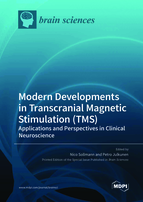Modern Developments in Transcranial Magnetic Stimulation (TMS) –Applications and Perspectives in Clinical Neuroscience
A special issue of Brain Sciences (ISSN 2076-3425). This special issue belongs to the section "Sensory and Motor Neuroscience".
Deadline for manuscript submissions: closed (15 August 2021) | Viewed by 45744
Special Issue Editors
Interests: neuroradiology; neuroimaging; spine imaging; body composition; paraspinal muscles; oncology; MRI; CT
Special Issues, Collections and Topics in MDPI journals
2. Department of Applied Physics, University of Eastern Finland, Kuopio, Finland
Interests: TMS technology; neuroscience methods; multi-modal imaging; neuronavigation; neurophysiology; diagnostics; motor mapping; plasticity; neuromodulation; therapeutic TMS
Special Issue Information
Dear Colleagues,
Transcranial magnetic stimulation (TMS) is being increasingly used in neuroscience and the clinical setup. Modern advances include but are not limited to the combination of TMS with precise neuronavigation as well as the integration of TMS into a multimodal environment, e.g., by guiding TMS application using complementary techniques such as functional magnetic resonance imaging (fMRI), electroencephalography (EEG), diffusion tensor imaging (DTI), or magnetoencephalography (MEG). Furthermore, the impact of stimulation can be identified and characterized by such multimodal approaches, helping to shed light on basic neurophysiology and TMS effects in the human brain. Against this background, the aim of this Special Issue is to explore advancements in the field of TMS considering both investigations in healthy subjects as well as patients. Submissions of research using neuronavigated TMS, aiming at technical developments of TMS, and using multimodal approaches with TMS as an integral part are particularly encouraged. We invite contributions in the form of original research articles, review articles, and case reports.
Dr. Nico Sollmann
Prof. Dr. Petro Julkunen
Guest Editors
Manuscript Submission Information
Manuscripts should be submitted online at www.mdpi.com by registering and logging in to this website. Once you are registered, click here to go to the submission form. Manuscripts can be submitted until the deadline. All submissions that pass pre-check are peer-reviewed. Accepted papers will be published continuously in the journal (as soon as accepted) and will be listed together on the special issue website. Research articles, review articles as well as short communications are invited. For planned papers, a title and short abstract (about 100 words) can be sent to the Editorial Office for announcement on this website.
Submitted manuscripts should not have been published previously, nor be under consideration for publication elsewhere (except conference proceedings papers). All manuscripts are thoroughly refereed through a single-blind peer-review process. A guide for authors and other relevant information for submission of manuscripts is available on the Instructions for Authors page. Brain Sciences is an international peer-reviewed open access monthly journal published by MDPI.
Please visit the Instructions for Authors page before submitting a manuscript. The Article Processing Charge (APC) for publication in this open access journal is 2200 CHF (Swiss Francs). Submitted papers should be well formatted and use good English. Authors may use MDPI's English editing service prior to publication or during author revisions.
Keywords
- transcranial magnetic stimulation
- neuronavigation
- cortical mapping
- neuroimaging
- multimodal approach
- neuroplasticity
- neuroradiology








